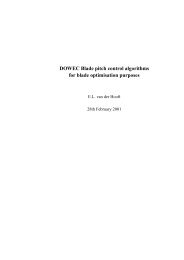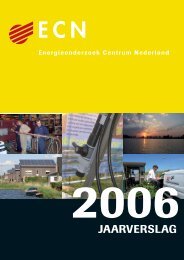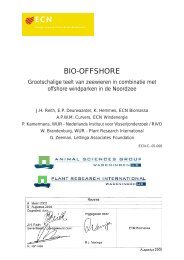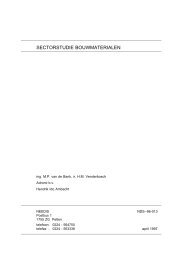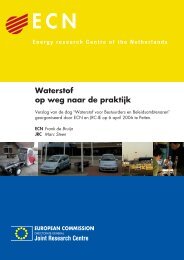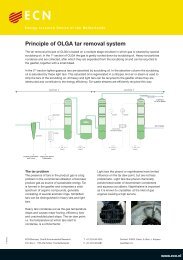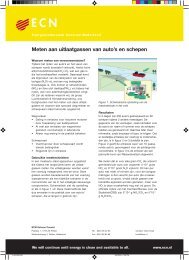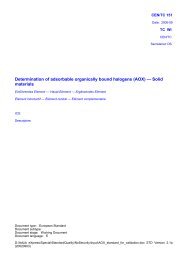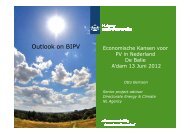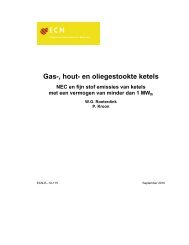PDF format (503 kB) - ECN
PDF format (503 kB) - ECN
PDF format (503 kB) - ECN
You also want an ePaper? Increase the reach of your titles
YUMPU automatically turns print PDFs into web optimized ePapers that Google loves.
e lower then 100% because labels can not be attached as easily and the printability is worse than for normal<br />
cans.<br />
PS and PP cups<br />
Cups made from thermoformed plastics are used for packing of yogurt and butter. Popular materials are PS, PP<br />
and PVC with market shares of respectively 52, 15 and 25% [APME, 1996]. We will model two cups. One is<br />
made from PS and has a weight of 14 grams and capable of packing 500 gram product. The other cup is made<br />
from PP and weighs 12 gram [Phylipsen, 1993].<br />
PE pouch and PC bottle<br />
Both Tetra Pak and Elopak have introduced flexible packaging (pouches) for milk and juice. The pouches are<br />
made out of plastic. Tetrapak uses LLDPE and Elopak uses multiple layer PP laminates [Couwenhoven, 1996].<br />
The advantage of using pouches for liquid packaging is that they are extremely light. An empty 1 liter pouch<br />
from Elopack weighs 10 grams while an empty 1 liter pouch from Tetra Pak only weighs 4 grams. We will<br />
model the Tetra Pack pouch as improvement option for current packaging options. It needs to be taken into account<br />
that this option asks for a change in consumer behavior because a pouch does not have the same packaging<br />
characteristics as non-flexible packaging.<br />
In the Netherlands the PC bottle is introduced as an alternative for liquid board milk packaging. We will model<br />
this bottle (trip number of 30 and a weight of 80 grams for a liter bottle) as alternative for current packaging<br />
types for non carbonated drinks.<br />
2.2 Non-food bottles<br />
Non-food bottles are used to pack shampoos, detergents and other cleaning liquids, lubricants, and light cleaning<br />
chemicals. Contrary to food bottles not as many different materials are used to pack the liquids. The food<br />
sector puts high demands on the quality of the material because properties like CO2 and oxygen permeability<br />
are very important for the durability and quality of the packed product. In the non-food sector these factors are<br />
less important.<br />
The main material used to produce non-food bottles is HDPE. We estimate the amount of non-food bottles on<br />
the HDPE blow moulding data for Europe. In 1994 about 1125 ktonne HDPE bottles were used in Europe<br />
[APME, 1996]. Besides non-food bottles also the U.K. milk bottles are made out of HDPE. This leaves 1050<br />
ktonne HDPE for non-food bottles.<br />
For the MARKAL model we define a non-food bottle with a volume of 0.5 liter and a weight of 50 grams. Several<br />
improvement options can be modeled. Based on SVM (1992-1996) we estimate that it is possible to reduce<br />
the weight with 25%. Furthermore bottles can be made with a recycled HDPE content of 50% [SVM, 1994].<br />
Two other options are more difficult to implement: a refill package made out of cardboard (14 grams) and a<br />
plastic pouch (5 grams).<br />
2.3 Boxes for primary packaging<br />
The category ‘boxes (primary packaging)’ consists of all the non-flexible packaging that is used as primary<br />
packaging to pack food and non-food products. To estimate the amount of boxes used as primary packaging in<br />
Europe we make use of statistics on the materials that are used to make the boxes. In PPI (1997) the total<br />
amount of packaging board consumption in Western Europe is estimated at 4.8 Mtonnes. Subtracting the share<br />
for liquid packaging (745 ktonne) leaves 4 Mtonnes of board.<br />
Besides cardboard, also plastic is a popular material for the production of boxes. In general plastic boxes have<br />
very thin walls and are not very durable. We estimate that the majority of these boxes are made out of thermoformed<br />
sheets. In Europe the amount of thermoformed sheets that are used as packaging is 1220 ktonnes in<br />
1994 [APME, 1996].



